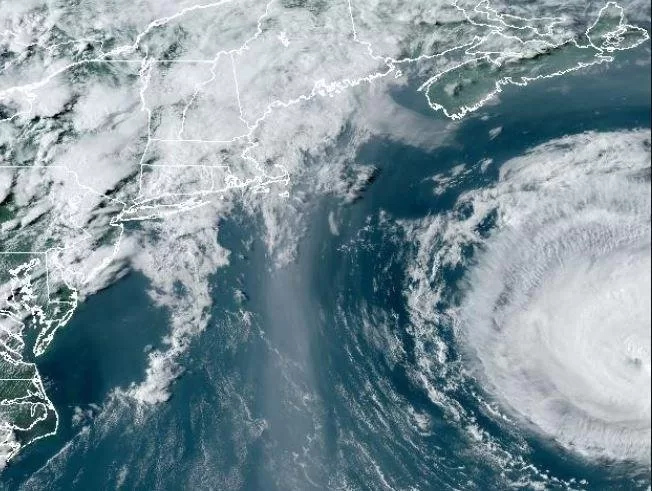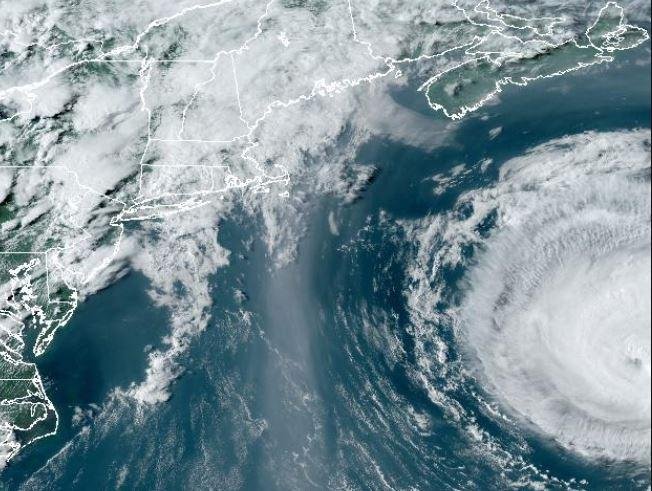Ernesto struck Bermuda as a Category 1 storm Saturday morning and was headed to Canada. Image courtesy of the National Oceanic and Atmospheric Administration
Aug. 19 (UPI) — Ernesto continued to gather strength early Monday after regaining hurricane status over night, according to forecasters who warn it is setting it sights on Canada after striking Bermuda as a Category 1 storm.
The system had maximum sustained winds of 85 mph as of 5 a.m. EDT, up 5 mph from late Sunday, according to the National Hurricane Center’s early Monday update.
Ernesto was located about 340 miles south-southeast of Halifax, Nova Scotia, and about 580 miles southwest of Cape Race, Newfoundland.
It was moving north-northeast at 21 miles per hour.
Forecasters expect Ernesto pass southeastern Newfoundland late Monday or early Tuesday.
Forecasters over night had said that Ernesto could also continue to strengthen before it moves north of the Gulf Stream’s north wall.
“After that, the system should quickly decay as it moves over colder water and encounters increasing southwesterly shear,” the NHC said in a discussion on the storm.
Though Ernesto is forecast to remain well off the U.S. East Coast, the forecasters are warning those who reside there that swells generated by the hurricane will be hitting the coast during the early half of this week.
“Beachgoers should be aware that there is a significant risk of life-threatening surf and rip currents, and should stay out of the water if advised by lifeguards,” NHC said.
NWS in New York said in a hazard message that “up to one half foot of inundation above ground level expected in vulnerable areas near the waterfront and shoreline.”
In New York City, ocean-facing beaches were closed for swimming in Brooklyn and Queens over the weekend. That includes Coney Island.
Accuweather.com forecasts Ernesto to impact the British Isles from Wednesday night to Thursday.
“As Ernesto moves along, it will be of concern for ships at sea over the North Atlantic from Tuesday to Wednesday,” Accuweather.com forecaster Alex Sosnowski said. “The storm will accelerate and may reach forward speeds of 30-40 mph. Seas ahead of the storm will quickly build to 20-30 feet.”
For the next two days, life-threatening surf and rip current conditions are likely for the Bahamas, Bermuda, the East Coast of the United States and Atlantic Canada, NHC said.
Two Ohio men are dead died after getting caught in rip currents hours apart in separate beaches on Hilton Head Island, S.C., on Friday as the hurricane moved north in the Atlantic Ocean, CNN reported.
Hurricane-force winds extend outward up to 35 miles from the center and tropical storm-force winds up to 220 miles away.
Bermuda Premier David Burt said Saturday night “there are a significant number of people without power, and anyone on the roads will impede the progress of the restoration of the power efforts and also the restoration of the roads and clearing of roads which may be blocked.”
A total of 8,331 customers were without power among the island’s 64,626 residents Sunday afternoon.
No major damage in Bermuda has been reported.
The storm strengthened into a hurricane Wednesday, continued intensifying throughout Thursday and hit Category 2 status Thursday night with sustained winds of 100 mph.
Ernesto’s center never made landfall over Puerto Rico or the U.S. Virgin Islands where it knocked out power to hundreds of thousands of customers.
Heavy rain soaked the Virgin Islands on Tuesday and Wednesday.
Debby was a Category 1 storm that made landfall in the Florida Panhandle and then moved through the U.S. Atlantic Coast last week causing torrential rain and widespread, record flooding up the eastern seaboard.
Beryl struck parts of the Caribbean, the Yucatán Peninsula and the Gulf Coast of the United States in late June and early July.
Two tropical storms were in the Gulf of Mexico in June: Cindy and Alberto.

